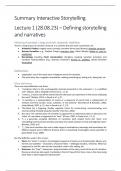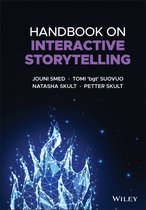Summary Interactive Storytelling
Lecture 1 (28.08.23) – Defining storytelling
and narratives
Historical context: Long and rich research tradition
There’s a long history of narrative research. It is a theme that has been researched a lot.
• Aristotle’s Poetica: tragedy versus comedy, narrative forms (epic/drama), dramatic structure
• Russian formalism: e.g., Vladimir Propp’s character roles, Viktor Skloskij: fabula vs. sujet vs.
media/text
• Narratology including Frech structuralism: discipline studying narrative principles and
narrative representations (e.g., Seymour Chatman’s kernels vs. satellites, Gérard Genettes
focalization
Definitions
• Laypeople’s use of the word story: Instagram stories for example.
• The word story has a negative connotation: making something up, telling a lie, being bad, etc.
Many definitions
There are many definitions out there:
1. “narratives refers to the unchangeable material presented to the interactor […] a solidified
rock” (Adams, 2013, adopted by Smed et al., 1.1.2)
2. “a story […] means now all the events that the interactor can experience in the course of playing
the work” (Adams, 2013, in Smed et al., p.7)
3. “a narrative is a representation of events or a sequence of events that is independent of
medium and form (audio, visual, symbolic, in real actions)” (Kinnebroch & Bilandzic, 2006,
citing Abbott, 2002, p. 12, also in Smed et al., 1.1.2)
4. “Narrative [is] a forgiving, flexible cognitive frame for constructing, communicating, and
reconstructing mentally projected worlds” (Herman, 2002)
5. the story “the content plane of narrative as opposed to its expression plane or discourse; the
‘what’ of a narrative as opposed to its ‘how’” (Prince, 1987, in Smed et al., 1.1.2)
6. “[…] a generally accepted definition of narratives (and related terms like ‘story’ and
‘storytelling’) seems elusive and thus any hope of a simple solution on that end might be naïve”
(Koenitz, 2018, p.4)
7. “[…] the term narratives has such a wide range of contradictory meanings and associations for
different people and in different theories that it is practically meaningless unless specified in
great detail” (Juul, 2005)
But the definition used in this course:
• Story: the “what” / content: chronological sequence of events on a timeline (plot, fabula, arc);
Kernels and satellites – Characters; Character Roles – Settings() (location, timeline). What has
happened in real life, who are the characters, what is the setting, etc.
• Discourse: the “how” / expression: (re)presentation of the story, result of the act of narration,
Discourse structure (aka sujet); Focalization; Point of View (PoV); Voice. How is the story being
told? How is what happened represented?
,Defining narrative and storytelling
The term narrative includes both a story and its telling (discourse).
Defining a narrative
A narrative consists of:
• Story: a chronological event sequence
Event 1 → event 2 → event 3 → event n
• The story is transmitted through a discourse: the (re)presentation of the story, which is the
result of the act of narration/telling
Story structure, events and discourse structure
• Story plot = sequence of events on a timeline = event structure
o Event: a change of state, something happening, usually involving a character
o Plot event: plot point = narrative turn; dramatically significant event that makes
everything change
o Causality: “a cause-and-effect chain of events”, so: an event today happens because of
an event yesterday (events are linked)
• Discourse structure – the order of narrated events. How the events are being told.
o E.g., chronological, in medias res, flashbacks, flashforwards
o Discourse structures can evoke certain emotions: surprise, curiosity, and suspense
Story structure (plot)
Freytag’s dramatic arc (“pyramid”), but there are other story structures as well.
,Other story structures:
• Aristotle: beginning – middle – end
• Three-Act structure: similar to Aristoteles story structure
• Campbell’s hero’s journey (‘monomyth’): hero needs to move away, they are being confronted
with challenges, then they come back home changed.
• Labov & Waletzky’s story structure, including and Evaluation: see below
Labov and Waletzky’s story structure (1967): Inherent structural order of narratives
• Orientation: opening storyworld -> who/wat/where/when
• Complicating actions: something is happening, sequence of unfolding events, moving the story
forward.
• Critical event: tellable event, central in the story. This is the reason for telling the story.
• Resolution: outcome of the story: how did it end?
• Evaluation: comments on the significance and meaning of the events – the take-home message
• Coda: transition to the here and now. The story has ended but how are they doing now?
Tellability
• Newsworthiness/reportability/the “raison d’être” of the story
• A tellable event is the critical event in the story structure
• The event that makes the story worth telling and worthy of the audience’s attention.
o Something extraordinary/remarkable/unexpected/wonderful.
• Finding a tellable event is the starting point when you create your story structure.
• Example of tellable events:
o Being acquitted in court after having left your child in a car on a hot summer day
o Finding a medicine curing the medical condition you have been suffering from for years
o Being taken under the wing of a humanitarian organization while fleeing from Syria
under terrible circumstances
Evaluation(s)
• Also part of Labov and Waletzky’s story structure
• An evaluation is not an event, but they comment on events.
• The narrator’s comments on the significance and meaning of the events
o Not an event itself
o The ‘so what?’ of question is answered by this: answering questions like “what does
this all mean?” / “so what?”
• Functions to make the point of the narrative clear, includes the take-home message.
• They can be throughout the story or in the end of the story.
, In the case of people forgetting to take their child out of their car on a hot summer day?
• Evaluation = it could happen to anyone – it is a horrible mistake
Kernels vs. satellites
Events function as either kernel or satellite:
• Kernel: crucial or critical events. Obligatory event that guarantees the story’s coherence/logic;
essential content of the story; part of a story’s identity; initiates, increases or concludes an
uncertainty, so it advances or outlines a sequence of transformations; they are plot points. You
cannot leave them out of the story.
• Satellite: serves to embellish the basic plot; content that can be omitted without changing the
identity of the story; amplify or fill in the outline of a sequence by maintaining, retarding, or
prolonging the kernel events they accompany or surround; also called pinch points. They can
be left out of the story.
Increasing narrativity
Narrativity
Narrativity is an element or ingredient om the narrative, an attribute of the text.
• “we define narrativity as the presence and interaction of a set of textual elements that
distinguish narrative texts from non-narrative texts and that constitute the potential of a text
to create a rich mental representation of the story and to generate transportive experiences”
Narrativity is not a dichotomous characteristic – a text is not either narrative or non-narrative
- , but a continuous attribute that can be found in almost any text – but to a varying degree.”
(Kinnebrock & Bilandzic, 2006, p.5)
Narrativity factors (NFs)
Narrativity factors ≈ narrative elements
Both at the story and discourse level.





